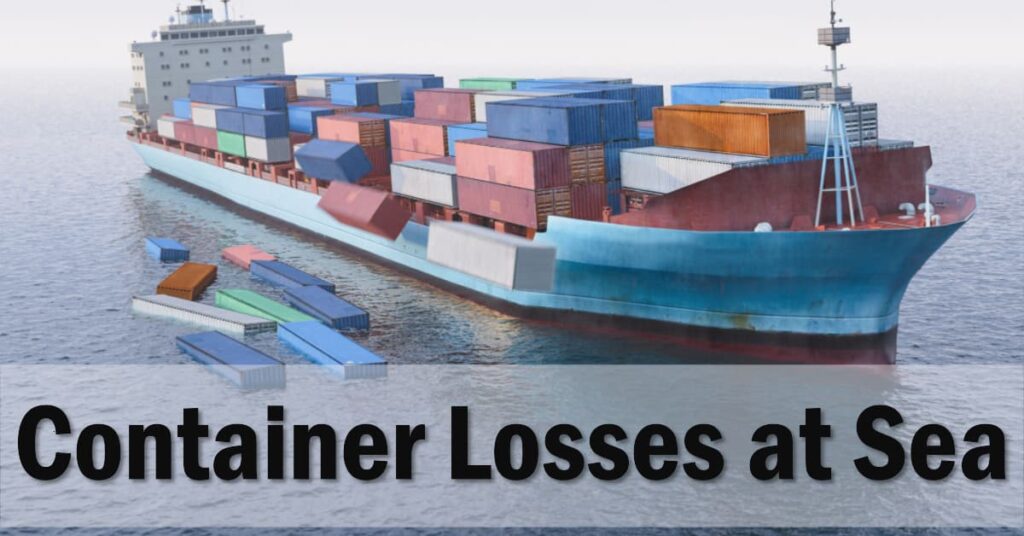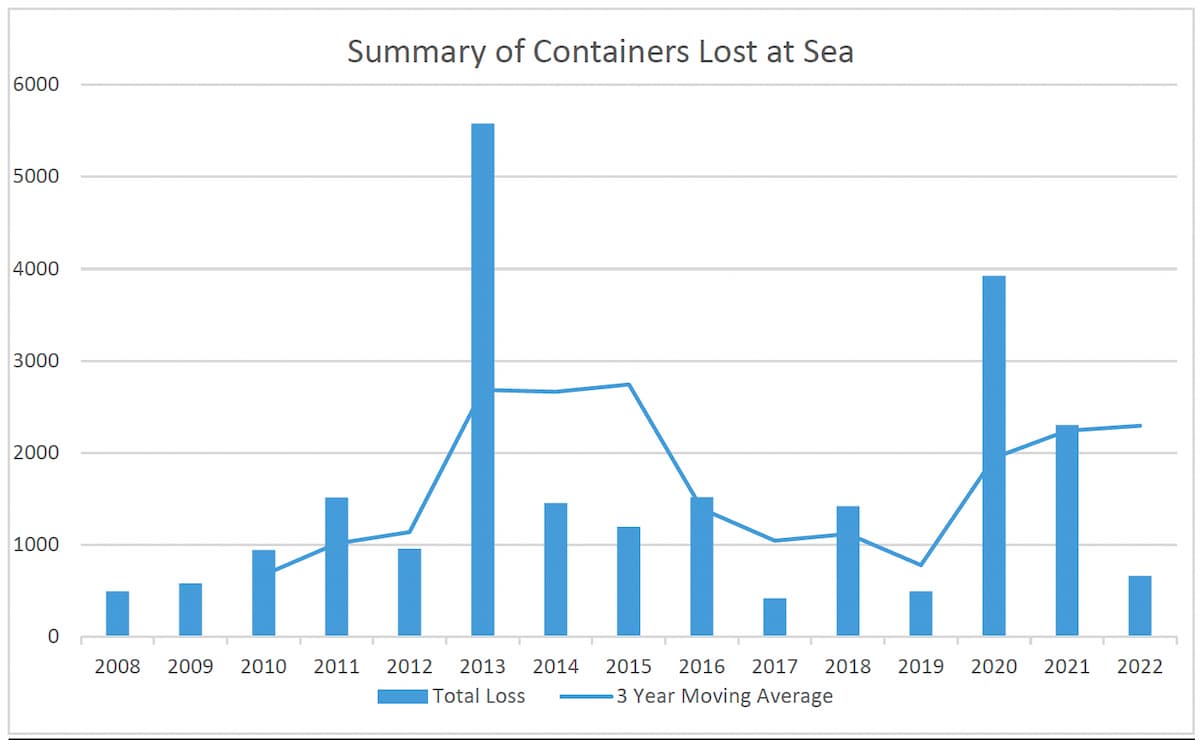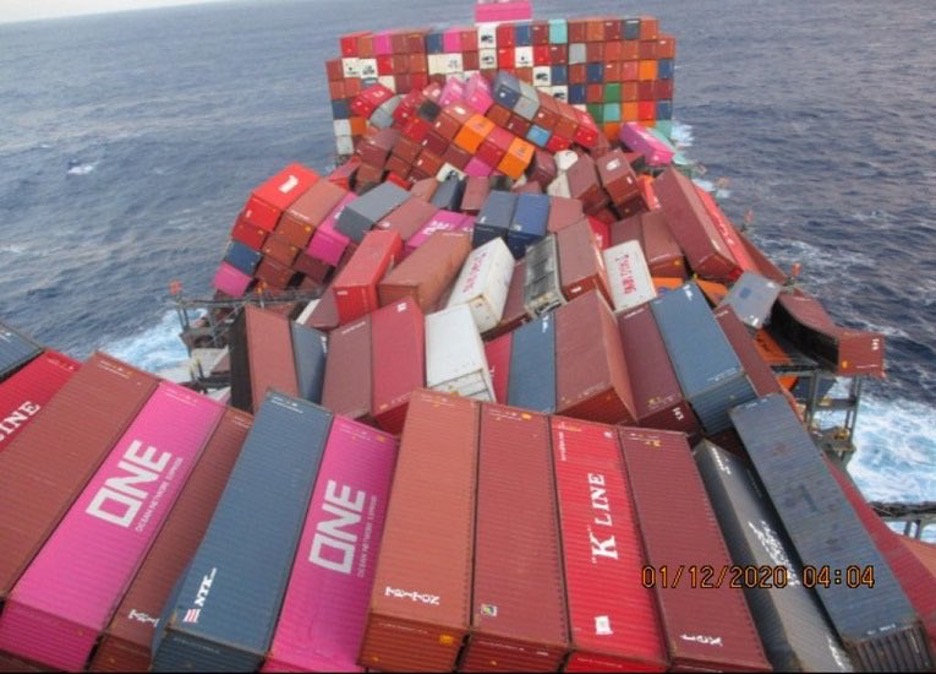Every year, thousands of shipping containers are lost at sea, causing significant financial and environmental damage. The frequency of container losses at sea has been a growing concern for the global shipping industry, with various factors contributing to the problem.
Understanding how many containers are lost at sea, the extent of the issue, and its impact is crucial in developing effective measures to reduce container losses.
According to the World Shipping Council, an average of 1,382 containers were lost at sea between 2018 and 2019. However, in recent years, there have been significant incidents where hundreds or even thousands of containers have been lost in a single event.
For instance, in December 2020, around 1,800 shipping containers fell overboard from a vessel in the Pacific Ocean, causing widespread concern about the environmental impact and financial losses.
The impact of lost containers is significant, ranging from environmental pollution to economic losses. Efforts are underway to mitigate the issue, including improving container design, enhancing vessel stability, and developing better tracking and recovery systems. However, addressing the problem requires a collaborative effort from all stakeholders in the shipping industry.

Understanding the Global Shipping Industry
The global shipping industry is a complex and vital part of the world economy. It is responsible for the transportation of goods across the world’s oceans, connecting producers and consumers across continents. The industry is comprised of a vast network of shipping lines, ports, and logistics providers that work together to move goods efficiently and reliably.
The shipping industry is a highly competitive business, with companies vying for market share and striving to reduce costs. Shipping lines operate a variety of vessels, including container ships, bulk carriers, and tankers, each designed to transport specific types of cargo. Container ships are the most common type of vessel used for international trade, carrying everything from electronics to clothing to food products.
Ports are critical components of the shipping industry, serving as the interface between land and sea transportation. They are responsible for loading and unloading cargo, as well as providing storage and other logistical services. Major ports around the world are equipped with state-of-the-art facilities and technology to handle the massive volume of goods that pass through them.
The shipping industry is subject to a wide range of regulations and standards aimed at ensuring safety, security, and environmental sustainability. International organizations such as the International Maritime Organization (IMO) and the World Shipping Council (WSC) work to establish and enforce these regulations, which cover everything from vessel design and construction to crew training and pollution prevention.
In conclusion, the global shipping industry is a complex and dynamic sector that plays a critical role in the world economy. As the demand for goods and services continues to grow, the industry will face new challenges and opportunities, requiring innovative solutions and a commitment to sustainability and safety.
Frequency of Container Losses at Sea
According to the World Shipping Council (WSC) Containers Lost at Sea Report covering 2020-2021, containers lost overboard represent less than one-thousandth of 1 percent (0.001%) of deliveries. However, the past two years have seen an increase in the number of containers lost at sea, causing concern among industry experts.
The WSC has decided to increase the frequency of its Containers Lost at Sea report due to the unusually high number of incidents in the winter of 2020-21. The report plays an essential role in enhancing container safety by providing accurate data.

The International Maritime Organization (IMO) has also agreed to establish a compulsory system to declare the loss of containers and set up means on board to easily identify the exact number of losses. Ships are obliged to report the loss of container(s) through a standardized procedure, possibly detailing identification and cargo carried.
Mega container ships have been identified as one of the main culprits for the increase in container losses at sea. These ships are capable of carrying over 20,000 containers, and when fully loaded, they can experience intense rolling, which increases the risk of containers being dislodged and lost overboard.
In conclusion, while the percentage of containers lost at sea is relatively low, the increase in the number of incidents in recent years has highlighted the need for greater container safety measures. The mandatory reporting system established by the IMO and the increased frequency of the WSC Containers Lost at Sea report are steps in the right direction towards enhancing container safety.

Factors Contributing to Container Losses
Container losses at sea are caused by a variety of factors. Understanding the contributing factors is essential to reducing the number of containers lost at sea. Weather conditions, structural issues, and human error are the three primary factors that contribute to container losses at sea.
Weather Conditions
Weather conditions are one of the most significant factors contributing to container losses at sea. Strong winds, heavy rainfall, and high waves can cause containers to shift and fall off ships. Extreme weather events such as hurricanes and typhoons can also cause significant damage to ships and lead to container losses.
Structural Issues
Structural issues with ships and containers can also contribute to container losses at sea. Poor maintenance, aging vessels, and inadequate design can all lead to structural issues that increase the likelihood of container losses. In addition, improper loading and securing of containers can cause structural issues and lead to container losses.
Human Error
Human error is another significant factor contributing to container losses at sea. Failure to follow guidelines, poor distribution of weight, improper packing of cargo, and human fatigue can all result in containers being more likely to come loose at sea. The shipping industry also relies heavily on the reliability of its equipment, and any failure in equipment can lead to container losses.
In conclusion, reducing the number of containers lost at sea requires a comprehensive approach that addresses the contributing factors. Weather conditions, structural issues, and human error are the three primary factors that contribute to container losses at sea. By addressing these factors, the shipping industry can improve container safety and reduce the number of containers lost at sea.
What Happens When Shipping Containers Fall Overboard?
When shipping containers fall overboard, they can cause significant damage to the environment and pose a safety hazard to other vessels. The World Shipping Council reports that an average of 1,390 shipping containers are lost at sea each year, and this number has been increasing in recent years.
Containers that are lost at sea can float for several weeks or months, depending on their weight and buoyancy. During this time, they can be carried by ocean currents and wind, making it difficult to predict where they will end up.
When a container finally sinks, it can damage the seafloor and marine life. Containers may contain hazardous materials, such as chemicals or batteries, which can be harmful to the environment.
In addition to the environmental impact, lost containers can also be a financial burden for shipping companies. The cost of replacing lost containers and compensating for damaged cargo can be significant.
To prevent containers from falling overboard, shipping companies must ensure that they are properly secured and stowed on the vessel. Regular inspections and maintenance of container lashing systems can also help prevent accidents.
Overall, the loss of shipping containers at sea is a serious issue that requires attention from both the shipping industry and regulators. By taking steps to prevent accidents and improve container safety, companies can reduce the environmental impact and financial costs of lost containers.
Impact of Lost Containers
When shipping containers are lost at sea, it can have significant environmental and economic consequences. This section will explore the impact of lost containers on the environment and economy.
Environmental Consequences
Lost shipping containers can cause harm to marine life and the environment. Containers that sink to the ocean floor can damage coral reefs and other underwater ecosystems. The contents of the containers can also be hazardous to marine life. For example, if a container was carrying chemicals, those chemicals could leak into the water and harm marine life.
In addition to the immediate environmental impact, lost containers can also have long-term consequences. Containers that remain on the ocean floor can corrode and release toxic substances into the water over time. This can have a negative impact on the health of marine ecosystems and the organisms that rely on them.
Economic Implications
The loss of shipping containers can also have significant economic implications. Shipping companies may face significant financial losses if their cargo is lost at sea. In addition to the cost of the lost cargo, companies may also face legal fees and other expenses related to the incident.
The loss of cargo can also impact the global economy. If a container was carrying goods that were in high demand, the loss of that cargo could lead to shortages and price increases. This can have a ripple effect throughout the supply chain, impacting businesses and consumers around the world.
Overall, the impact of lost shipping containers can be significant. From environmental damage to economic losses, the consequences of lost cargo can be far-reaching.
Efforts to Reduce Container Losses
Container losses at sea have become a major concern for the shipping industry. Efforts are being made to reduce container losses and ensure the safety of cargo and crew. Technological advancements and regulatory measures are two key areas that are being focused on to address this issue.
Technological Advancements
New technologies are being developed to improve container safety and reduce losses at sea. Some of these advancements include:
- Smart Containers: These containers are equipped with sensors that can monitor temperature, humidity, and other environmental factors. They can also track the container’s location and provide real-time data to the shipping company.
- Container Weight Verification: The International Maritime Organization (IMO) has made it mandatory for shipping companies to verify the weight of containers before they are loaded onto a ship. This helps to ensure that the weight of the cargo is evenly distributed and reduces the risk of container loss.
- Automated Stowage Planning: This technology can optimize the placement of containers on a ship to ensure that they are evenly distributed and reduce the risk of container loss.
Regulatory Measures
Regulatory measures are also being implemented to reduce container losses at sea. Some of these measures include:
- The IMO’s Code of Practice for Packing of Cargo Transport Units (CTU Code): This code provides guidelines for the safe packing and securing of cargo in containers. It also requires that containers be inspected for damage before they are loaded onto a ship.
- The Container Safety Convention (CSC): This convention requires that containers be inspected and certified before they are used for shipping. It also requires that containers be inspected periodically to ensure that they remain in good condition. Hardcopy is available at Amazon.
- The International Convention for the Safety of Life at Sea (SOLAS): This convention requires that shippers provide accurate weight information for containers before they are loaded onto a ship. It also requires that containers be stowed in a safe and secure manner.
In conclusion, the shipping industry is taking steps to reduce container losses at sea. Technological advancements and regulatory measures are being implemented to improve container safety and ensure the safety of cargo and crew.
Conclusion
Based on the research conducted by the World Shipping Council, between 2008 and 2019, an average of 1382 shipping containers were lost at sea each year. In 2019, approximately 16,000 cargo containers were lost at sea. While this may seem like a large number, it is important to note that containers lost overboard represent less than one-thousandth of 1% (0.001%) of the roughly 226 million containers shipped each year.
The loss of containers at sea can have a significant impact on the environment, as well as the economy. When containers sink to the ocean floor, they can damage marine ecosystems and pose a hazard to shipping lanes. Additionally, the loss of cargo can result in financial losses for shipping companies and insurers, as well as disruptions to global trade.
Efforts are being made to minimize the number of containers lost at sea, including the development of new technologies to improve container tracking and the implementation of stricter regulations for container stowage. Shipping companies and industry organizations are also working to raise awareness of the importance of proper container handling and stowage to prevent accidents and reduce the risk of containers being lost at sea.
Overall, while the loss of containers at sea is a significant issue, it is important to keep in mind that it represents a small fraction of the total number of containers shipped each year. With continued efforts to improve container handling and stowage practices, it is possible to further reduce the number of containers lost at sea and minimize the impact of these incidents on the environment and the economy.
Frequently Asked Questions
How many containers are lost at sea each year?
According to the World Shipping Council, there was an average of 1,382 containers lost at sea each year between 2008 and 2019. However, in 2022, only 661 containers were lost at sea, which represents the lowest losses in percentage since the start of the survey in 2008.
What is the average value of cargo lost in a container ship accident?
The average value of cargo lost in a container ship accident varies depending on the contents of the containers. For example, a container carrying high-value electronics or luxury goods may have a much higher value than a container carrying raw materials. However, it is estimated that the total value of cargo lost in container ship accidents is in the billions of dollars.
How many shipping containers are currently lost at sea?
It is difficult to determine the exact number of shipping containers currently lost at sea. However, it is estimated that there are tens of thousands of containers lost at sea each year.
What percentage of shipping containers are lost at sea?
The percentage of shipping containers lost at sea is relatively low compared to the total number of containers transported each year. In 2022, 661 containers were lost at sea out of 250 million transported, representing only a fraction of a percent.
What are the main causes of shipping container losses at sea?
The main causes of shipping container losses at sea are rough weather, poor stowage, and structural failures of the containers or vessels. Human error, such as incorrect loading or securing of containers, can also contribute to container losses.
How are shipping container losses at sea reported and tracked?
Shipping container losses at sea are reported and tracked by various organizations, including the World Shipping Council and the International Maritime Organization. The data is collected through surveys and reports from shipping companies and other industry stakeholders.
- Sustainable and Luxurious: Discovering Split’s Yachting Paradise – April 26, 2024
- MarineTraffic vs VesselFinder: Which Is Better Vessel Tracking Service? – February 14, 2024
- Port Costs: A Comprehensive Guide to Port Dues and Fees for Cargo Ships – February 12, 2024




Leave a Reply